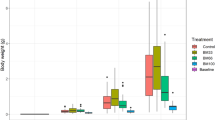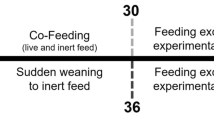Abstract
Fish bone by-products from the fish processing industry contain significant amounts of phosphates, which could be utilized as animal feed supplements that substitute conventional mined rock phosphates. The study evaluated whether two by-product derived ingredients (fish bone meal and inorganic dicalcium phosphate extracted from fish bones) could substitute conventional dietary phosphorous sources in formulated diets for African catfish, Clarias gariepinus, and thereby demonstrate a pathway through which these by-products can be valorised and utilized through a circular economy approach. Conventional feed phosphates were 100% substituted by fish bone meal (treatment FB), and 100% and 50% by inorganic dicalcium phosphate (treatments DCP100 and DCP50 respectively). All experimental diets sustained high specific growth rates of 4.83–4.99%.day−1, without any differences in final animal weight or body condition factor between treatments. Blood serum indicators of non-specific immune function were unaffected by dietary treatment, as were vertebrae mineral content and the Ca:P ratio. Whole body lipid accumulation was found for both diets that substituted 100% of conventional phosphates, but in the absence of other evidence it is unlikely that this indicates decreased dietary phosphorous availability of the ingredients. The study concludes that fish bone meal and inorganic dicalcium phosphate extracted from fish by-products can be a viable alternative dietary source of phosphorous, at least in the case of Clarias gariepinus. It is recommended that future research should include determining economic viability of these ingredients in aquafeeds, on estimating whether these ingredients cause increased environmental impacts relative to conventional mined feed phosphates.
Graphical Abstract



Similar content being viewed by others
Data Availability
Data are openly available as part of the appendices of a Masters thesis, published openly by Stellenbosch University.
Code Availability
N/A.
Abbreviations
- ANOVA:
-
Analysis of variance
- AOAC:
-
Association of Official Analytical Chemists
- CF:
-
Condition factor
- DCP:
-
Dicalcium phosphate
- EAA:
-
Essential amino acid
- EM:
-
Extruded maize meal
- FCR:
-
Feed conversion ratio
- FM:
-
Fish meal
- HPLC:
-
High performance liquid chromatography
- P:
-
Phosphorous
- RWG:
-
Relative weight gain
- SGR:
-
Specific growth rate
- SM:
-
Soybean meal
- Wi :
-
Initial weight
- Wf :
-
Final weight
References
Stegmann, P., Londo, M., Junginger, M.: The circular bioeconomy: its elements and role in European bioeconomy clusters. Resour. Conserv. Recycl. (2020). https://doi.org/10.1016/j.rcrx.2019.100029
D’Amato, D., et al.: Green, circular, bio economy: A comparative analysis of sustainability avenues. J. Clean. Prod. 168, 716–734 (2017)
Kirchherr, J., et al.: Barriers to the circular economy: evidence from the European Union (EU). Ecol. Econ. 150, 264–272 (2018)
Geissler, B., et al.: Striving toward a circular economy for phosphorus: the role of phosphate rock mining. Minerals 8, 395 (2018)
Ytteborg, E., et al.: Utilization of acid hydrolysed phosphorous from herring bone by-products in feed for Atlantic salmon (Salmo salar) start-feeding fry. Aquaculture 459, 173–184 (2016)
Herrera-Estrella, L., López-Arredondo, D.: Phosphorus: the underrated element for feeding the world. Trends Plant Sci. 21(6), 461–463 (2016)
Van Vuuren, D.P., Bouwman, A.F., Beusen, A.H.W.: Phosphorus demand for the 1970–2100 period: a scenario analysis of resource depletion. Glob. Environ. Change 20, 428–439 (2010)
Mew, M.C., Steiner, G., Geissler, B.: Phosphorus supply chain—scientific, technical, and economic foundations: a transdisciplinary orientation. Sustainability 10, 1087 (2018)
Piccirillo, C., et al.: Extraction and characterisation of apatite- and tricalcium phosphate-based materials from cod fish bones. Mater. Sci. Eng. C 33, 103–110 (2013)
Idowu, A.T., et al.: Effect of alkaline treatment on characteristics of bio-calcium and hydroxyapatite powders derived from salmon bone. Appl. Sci. 10, 4141 (2020)
Swart, J., Establishing processes in producing dicalcium phosphate, octacalcium phosphate and gelatin from monkfish (Lophius vomerinus) bones. In: Department of Process Engineering. p. 113. Stellenbosch University, Stellenbosch (2017)
Corrêa, T.H.A., Holanda, J.N.F.: Fish bone as a source of raw material for synthesis of calcium phosphate. Mater. Res. 22(Supplement 1), 1–5 (2019)
Gómez-Guillén, M.C., et al.: Functional and bioactive properties of collagen and gelatin from alternative sources: a review. Food Hydrocoll. 25, 1813–1827 (2011)
Swart, J., Bordoloi, A., Goosen, N.J.: Optimization of phosphate recovery from monkfish Lophius vomerinus processing by-products and characterization of the phosphate phases. J. Sci. Food. Agric. 99, 2743–2756 (2019)
Albrektsen, S., et al.: Utilization of H2SO4-hydrolysed phosphorus from herring bone by-products in feed for Atlantic salmon (Salmo salar) 0+ postsmolt. Aquacult. Nutr. 24(1), 348–365 (2018)
Lee, K.-J., et al.: Evaluation of supplemental fish bone meal made from Alaska seafood processing byproducts and dicalcium phosphate in plant protein based diets for rainbow trout (Oncorhynchus mykiss). Aquaculture 302, 248–255 (2010)
Shearer, K.D., Hardy, R.W.: Phosphorus deficiency in rainbow trout fed a diet containing deboned fillet scrap. Progres. Fish Cult. 49(3), 192–197 (1987)
Nordrum, S., et al.: Availability of phosphorus in fish bone meal and inorganic salts to Atlantic salmon (Salmo salar) as determined by retention. Aquaculture 157, 51–61 (1997)
Toppe, J., et al.: Inclusion of fish bone and crab by-products in diets for Atlantic cod, Gadus morhua. Aquaculture 253, 636–645 (2006)
Tacon, A.G.J., Metian, M.: Feed matters: satisfying the feed demand of aquaculture. Rev. Fish. Sci. Aquacult. 23(1), 1–10 (2015)
Naylor, R.L., et al.: Feeding aquaculture in an era of finite resources. Proc. Natl. Acad. Sci. U.S.A. 106(36), 15103–15110 (2009)
FAO: FAO Yearbook: Fisheries and Aquaculture Statistics. Food and Agricultural Association of the United Nations, Italy (2017)
Swanepoel, J.C., Goosen, N.J.: Evaluation of fish protein hydrolysates in juvenile African catfish (Clarias gariepinus) diets. Aquaculture 496, 262–269 (2018)
Kiron, V.: Fish immune system and its nutritional modulation for preventive health care. Anim. Feed Sci. Technol. 173, 111–133 (2012)
Hoffman, L., et al.: Observations on the effects of decreasing water temperatures on survival of Clarias gariepinus juveniles. South Afr. J. Wildl. Res. 21, 54–58 (1991)
Ali, M.Z., Jauncey, K.: Approaches to optimizing dietary protein to energy ratio for African catfish Clarias gariepinus (Burchell, 1822). Aquacult. Nutr. 11, 95–101 (2005)
Ahmad, M.H.: Response of African catfish, Clarias gariepinus, to different dietary protein and lipid levels in practical diets. J. Wolrd Aquacult. Soc. 39(4), 541–548 (2008)
CFR: Title 50 Wildlife and Fisheries Parts 600 to 659 (Revised as of October 1, 2013): 50-CFR-Vol-12, pp. 903–903. IntraWEB LLC, Longview (2013)
Glazer, J.P., Butterworth, D.S.,; An updated assessment of the South African Monkfish resource, Lophius vomerinus. Report No. FISHERIES/2013/SEPT/SWG-DEM/42. Department of Agriculture, Forestry and Fisheries, Cape Town (2013)
Greyling, N., Bordoloi, A., Goosen, N.J.: Optimizing enzymatic conditions of monkfish (Lophius vomerinus) heads hydrolysis towards potential waste biomass valorization. Biomass Convers. Biorefinery 11, 2711 (2020)
Gericke, S.J., et al.: Effects of dietary supplementation of endo-(1,4)-β-xylanase in plant-based diets on growth performance, hindgut microbial diversity, and blood chemistry in large on-growing African catfish (Clarias gariepinus). J. Appl. Aquacult. (2021). https://doi.org/10.1080/10454438.2021.2000920
Zor, T., Selinger, Z.: Linearization of the Bradford protein assay increases its sensitivity: Theoretical and experimental studies. Anal. Biochem. 236, 302–308 (1996)
Siwicki, A.K., Anderson, D.P., Rumsey, G.L.: Dietary intake of immunostimulants by rainbow trout affects non-specific immunity and protection against furunculosis. Vet. Immunol. Immunopathol. 41, 125–139 (1994)
Sankaran, K., Gurnani, S.: On the variation in the catalytic activity of lysozyme in fishes. Indian J. Biochem. Biophys. 9, 162–165 (1972)
Hecht, T., Pienaar, A.T.: A review of cannibalism and its implications in fish larviculture. J. World Aquacult. Soc. 24(2), 246–261 (1993)
Naumowicz, K., et al.: Intracohort cannibalism and methods for its mitigation in cultured freshwater fish. Rev. Fish Biol. Fish. 27, 193–208 (2017)
Mukai, Y., et al.: Reduced cannibalistic behavior of African catfish, Clarias gariepinus, larvae under dark and dim conditions. Zoolog. Sci. 30(6), 421–424 (2013)
Hecht, T., Appelbaum, S.: Observations on intraspecific aggression and coeval sibling cannibalism by larval and juvenile Clarias gariepinus (Clariidae: Pisces) under controlled conditions. J. Zool. 214, 21–44 (1988)
De Graaf, G., Janssen, H.: Artificial Reproduction and Pond Rearing of the African Catfish Clarias gariepinus in Sub-Saharan Africa—A Handbook. FAO Fisheries Technical Paper 362. Food and Agricultural Organisation of the United Nations, Rome (1996)
Baeverfjord, G., et al.: Mineral nutrition and bone health in salmonids. Rev. Aquacult. 11(3), 740–765 (2019)
Prabhu, P.A.J., Schrama, J.W., Kauskhik, S.J.: Quantifying dietary phosphorus requirement of fish—a meta-analytic approach. Aquacult. Nutr. 19(3), 233–249 (2013)
Ng, W.-K., Ang, L.-P., Liew, F.-L.: An evaluation of mineral supplementation of fish meal-based diets for African catfish. Aquacult. Int. 9, 277–282 (2001)
Sugiura, S.H., Hardy, R.W., Roberts, R.J.: The pathology of phosphorus deficiency in fish—a review. J. Fish Dis. 27(5), 255–265 (2004)
Suloma, A., Mabroke, R.S., El-Haroun, E.R.: Meat and bone meal as a potential source of phosphorus in plant-protein-based diets for Nile tilapia (Oreochromis niloticus). Aquacult. Int. 21, 375–385 (2013)
Vielma, J., Koskela, J., Ruohonen, K.: Growth, bone mineralization, and heat and low oxygen tolerance in European whitefish (Coregonus lavaretus L.) fed with graded levels of phosphorus. Aquaculture 212, 321–333 (2002)
Yoon, T.-H., et al.: Effect of a new phosphorus source, magnesium hydrogen phosphate (MHP) on growth, utilization of phosphorus, and physiological responses in carp Cyprinus carpio. Fish. Aquat. Sci. 19, 1–9 (2016)
Gottinger, A., Ladu, L., Quitzow, R.: Studying the transition towards a circular bioeconomy—a systematic literature review on transition studies and existing barriers. Sustainability 12, 8990 (2020)
Steiner, G., et al.: Efficiency developments in phosphate rock mining over the last three decades. Resour. Conserv. Recycl. 105, 235–245 (2015)
Acknowledgements
Funding for research costs was provided by the South African Protein Research Foundation under Grant Number P07/22/185/15, for which the authors are very grateful. Personal bursary funding for Mr. Swanepoel was obtained from the South African Oilseeds Advisory Committee, and the SA National Research Foundation (Grant Number TTK13070520623), and both these organisations are gratefully acknowledged. Opinions expressed and conclusions arrived at, are those of the authors and are not necessarily to be attributed to the funding organisations.
Funding
Funding for research costs was provided by the South African Protein Research Foundation under Grant Number P07/22/185/15. Personal bursary funding for Mr. Swanepoel was obtained from the South African Oilseeds Advisory Committee, and the SA National Research Foundation (Grant Number TTK13070520623).
Author information
Authors and Affiliations
Contributions
JCS planned and performed the research, collected, analysed and interpreted the data and produced a postgraduate research thesis based on his work. NJG conceptualized and sourced funding for the work, contributed to data analysis and interpretation, and prepared the manuscript. He was furthermore the sole academic supervisor for JCS through this study.
Corresponding author
Ethics declarations
Conflict of interest
Neither of the authors are currently or were previously employed by any of the funders, or organisations that work closely with the funders, and none of the funders had any hand in planning, performing or reporting of the research. Furthermore, neither of the authors are aware of any other actual or potential conflict of interest.
Ethical Approval
Ethics approval was obtained from the Stellenbosch University Research Ethics Committee: Animal Care and Use, under Protocol number SU-ACUD16-00062.
Consent to Participate
N/A.
Consent to Publication
N/A.
Additional information
Publisher’s Note
Springer Nature remains neutral with regard to jurisdictional claims in published maps and institutional affiliations.
Rights and permissions
About this article
Cite this article
Swanepoel, J.C., Goosen, N.J. In-Vivo Evaluation of the Suitability of By-Product-Derived Phosphate Feed Supplements for Use in the Circular Economy, Using Juvenile African Catfish as Model Species. Waste Biomass Valor 13, 4639–4649 (2022). https://doi.org/10.1007/s12649-022-01781-2
Received:
Accepted:
Published:
Issue Date:
DOI: https://doi.org/10.1007/s12649-022-01781-2




